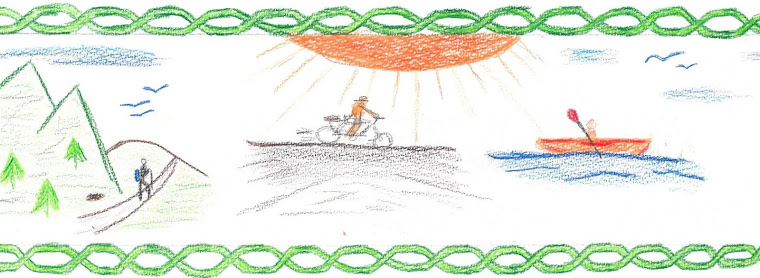I recently upgraded my camping sleeping system. It now consists
of four main components: a sleeping bag, a stuff sack that serves as a pillow,
a sleeping bag liner, and a sleeping pad.
| Sleeping bag, liner, pillow stuff sack, & pad |
Sleeping Bag
I chose synthetic over down because I already had a down bag.
Thinking I might be camping while exploring water trails via my kayak in
addition to backpacking, camping while bicycle touring, and car camping, I
wanted a synthetic bag that would still offer some insulation even when damp or
a little wet. After some research and snuggling into four of my top
preferences, I chose the Regular Length Marmot Cloudbreak 30 because it offered
the best fit.
Sleeping Bag Liner
Wanting to keep my bag clean and extend its temperature range, I
added a Sea to Summit Thermolite Reactor sleeping bag liner.
The liner theoretically extends the comfort range of my Cloudbreak down
to 15 degrees, but I have yet to experience anything colder than 30 degrees,
and then I was toasty warm. The liner also offers me the possibility of sleeping
in just it on top of the bag in warm weather. One night last August it was
rather warm when I turned in for the night. It was too warm to be in my bag so
I crawled into just the liner and it kept me warm. Only when the
temperature dropped a few hours later and I woke up cold did I zip the bag
around me.
Stuff Sack Pillow
I carry both the bag and liner in a nylon stuff sack made by
Outdoor Products. Half of the inside of the stuff sack is covered with fleece.
At night I turn the stuff sack inside out, stuff it with clothing or other soft
gear, and use it as a pillow.
Sleeping Pads
My sleeping pad is a closed cell ¾ length Therm-A-Rest RidgeRest SOLite. It provides enough
insulation and padding from the hard, cold ground to give me a good night’s
sleep. I was later seduced by a sale to obtain a full length open cell Therm-A-Rest NeoAir Voyager and added to that the Therm-A-Rest Trekker Chair ultralight, compact chair sleeve to
convert the mattress into a chair.
The SOLite is far lighter than the NeoAir Voyager but it also
takes up more space. The NeoAir Voyager offers more padding and insulation, and
takes up less space, but weighs more. There is also the possibility that the
NeoAir Voyager might spring a leak while in the field, resulting in no comfort
and no insulation, while the SOLite is practically indestructible. I can also
more easily use the SOLite to sit on during a rest stop than I can the NeoAir
Voyager.
For longer backpacking trips where weight and reliability is an
issue, I carry the SOLite. For shorter backpacking trips, cycling trips, and
car camping where weight is not as much an issue, and when I could get by for a
night or two if it sprang a leak, I carry the NeoAir Voyager. When I finally
take that overnight kayaking trip I will use the NeoAir Voyager because it will
be easier to fit into my kayak than the SOLite.
This post originally appeared on The Trek and has been slightly edited.

No comments:
Post a Comment